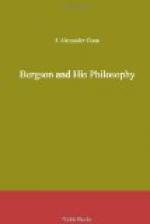Two illustrations, taken from the same essay, may serve to make this point clearer. A visitor in Paris, of an artistic temperament, makes some sketches of the city, writing underneath them, by way of memento, the word “Paris.” As he has actually seen Paris he is able, with the help of the original Intuition he has had of that unique whole which is Paris itself, to place his sketches therein, and synthesize them. But there is no way of performing the inverse operation. It is impossible, even with thousands of sketches, to achieve the Intuition, to give oneself the impression of what Paris is like, if one has never been there. Or again, as a second illustration, “Consider a character whose adventures are related to me in a novel. The author may multiply the traits of his hero’s character, may make him speak and act as much as he pleases, but all this can never be equivalent to the simple and indivisible feeling which I should experience if I were able, for an instant, to identify myself with the person of the hero himself. Out of that indivisible feeling, as from a spring, all the words, gestures, and actions of the man would appear to me to flow naturally. They would no longer be accidents which, added to the idea I had already formed of the character, continually enriched that idea without ever completing it. The character would be given to me all at once, in its entirety, and the thousand incidents which manifest it, instead of adding themselves to the idea and so enriching it, would seem to me, on the contrary, to detach themselves from it, without, however, exhausting it or impoverishing its essence. All the things I am told about the man provide me with so many points of view from which I can observe him. All the traits which describe him and which can make him known to me, only by so many comparisons with persons or things I know already, are signs by which he is expressed more or less symbolically. Symbols and points of view, therefore, place me outside him; they give me only what he has in common with others, and not what belongs to him, and to him alone. But that which is properly ‘himself,’ that which constitutes his essence, cannot be perceived from without, being internal by definition, nor be expressed by symbols, being incommensurable with everything else. Description, history, and analysis leave me here in the relative. Coincidence with the person himself would alone give me the absolute.” [Footnote: An Introduction to Metaphysics, p. 3.] This, as Gaston Rageot puts it, is “to understand in the fashion in which one loves.” This statement is of suggestive interest in considering the practical problem of how we may be said to “know” other people, and has vital bearing on the revelation of one personality to another, urging, as it does, the value and necessity of some degree of sympathy and indeed of love, for the full understanding and knowledge of any personality.




